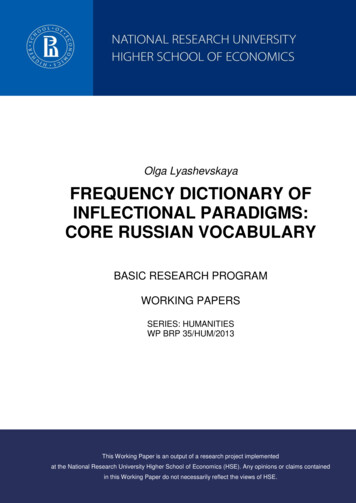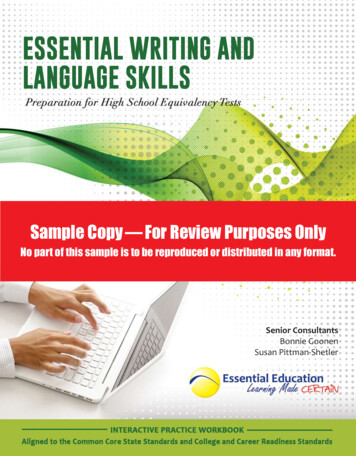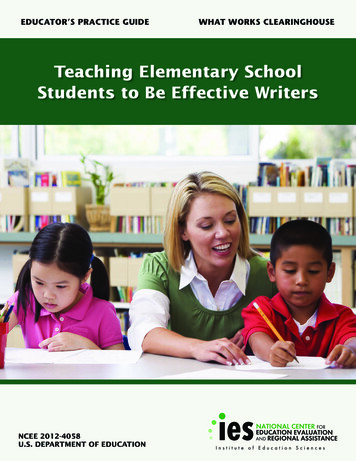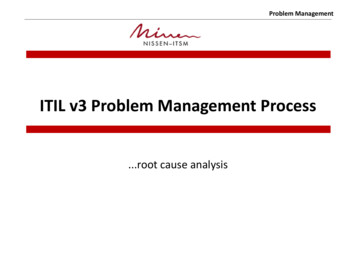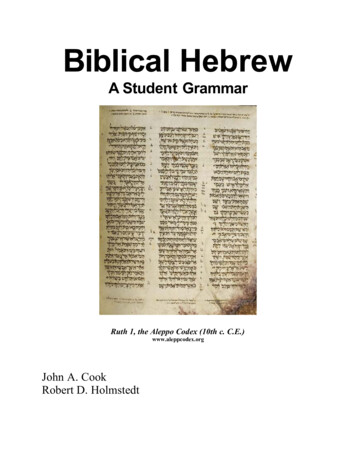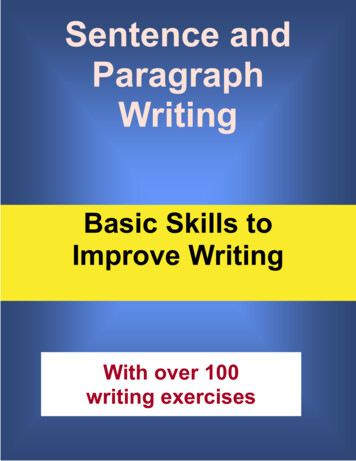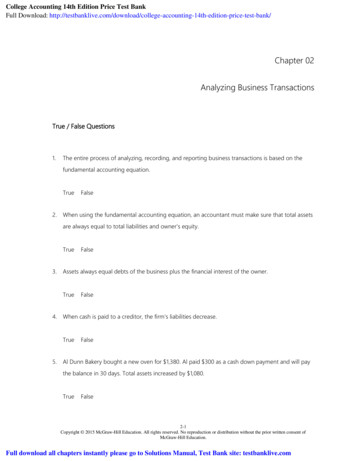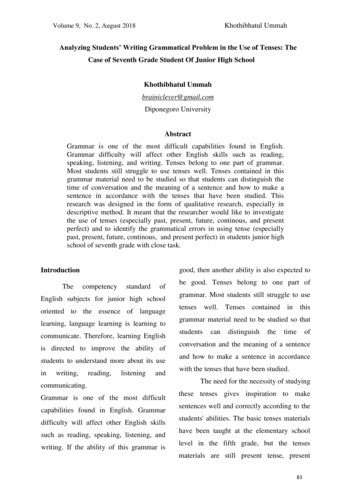
Transcription
Khothibhatul UmmahVolume 9, No. 2, August 2018Analyzing Students’ Writing Grammatical Problem in the Use of Tenses: TheCase of Seventh Grade Student Of Junior High SchoolKhothibhatul Ummahbrainiclever@gmail.comDiponegoro UniversityAbstractGrammar is one of the most difficult capabilities found in English.Grammar difficulty will affect other English skills such as reading,speaking, listening, and writing. Tenses belong to one part of grammar.Most students still struggle to use tenses well. Tenses contained in thisgrammar material need to be studied so that students can distinguish thetime of conversation and the meaning of a sentence and how to make asentence in accordance with the tenses that have been studied. Thisresearch was designed in the form of qualitative research, especially indescriptive method. It meant that the researcher would like to investigatethe use of tenses (especially past, present, future, continous, and presentperfect) and to identify the grammatical errors in using tense (especiallypast, present, future, continous, and present perfect) in students junior highschool of seventh grade with close task.good, then another ability is also expected toIntroductionThecompetencystandardofEnglish subjects for junior high schooloriented to the essence of languagelearning, language learning is learning tocommunicate. Therefore, learning Englishis directed to improve the ability ofstudents to understand more about its mmar is one of the most difficultcapabilities found in English. Grammardifficulty will affect other English skillssuch as reading, speaking, listening, andwriting. If the ability of this grammar isbe good. Tenses belong to one part ofgrammar. Most students still struggle to usetenseswell. Tensescontained inthisgrammar material need to be studied so thatstudentscandistinguishthetimeofconversation and the meaning of a sentenceand how to make a sentence in accordancewith the tenses that have been studied.The need for the necessity of studyingthese tenses gives inspiration to makesentences well and correctly according to thestudents' abilities. The basic tenses materialshave been taught at the elementary schoollevel in the fifth grade, but the tensesmaterials are still present tense, present83
Khothibhatul UmmahVolume 9, No. 2, August 2018continous, and present future. The materialGrammatical Eror- Dent In Using Simple Ofgiven is also still in the form of formulasTexts Of Bandar Lampung Model" written byand how to compose the sentence inJuwitasari, Raja, and Kadaryanto explainaccordance with the tenses that have beenabout how to investigate simple present tensetaught.was used by students in descriptive textTenses competence VII junior highwriting and to identify the common errorschool students who have been their use ismade by students’ in using simple presentthe skills gained from the information oftense in their descriptive text based onteachers, the teacher explains the formulasurface strategy taxonomy. The method usedof the use of tenses in a sentence then theis qualitative method, especially descriptiveteacherpositivemethod. The subject of this research was theinterrogativestudent of class XI A which consisted of 33sentences. After that the teacher gives astudent. The result shows that the studentsproblem related to the tenses. The abilityused more correct simple present tense thanof grammar tenses is needed to helperrors. A research written by Rosmawatistudents understand the meaning of aentittled “Error Analysis On Transformingreading, use of sentences when speaking,Affirmative To Negative And Interrogativeand understand how to make sentencesSentences Of Simple Present Tense (A Casewell and correctly.Study At The Second Years Of Smp YaperaThis research will discuss about theCiledug)” aims to find out some errors madegrammatical problem analysis of the use ofby the students in transforming affirmativetenses on grade VII students of SMP usingsimple present sentences into negative andmodel of close task problem. Based on theinterrogative ones, and identifying the causesbackground,researchof error made by the students. The subject ofquestion to analyze the problem that occurthis research was the second grade of SMPin junior high school students class gradeYAPERAseventh, the research question are : (1)conducted in theclass VIII-5, the writerWhat were the types errors made by theanalyzed 20 students. In this research, thestudents in using five tenses?, (2) Whatwriter used a qualitative method in a form ofcauses the students made errors in using ofdescriptivefive tenses?.included observation, collecting the esearch(percentage)wasthaterrortest, analyzing, and interpreting the data. Theanalysis in junior high school students hasresult of the research showed that the highestbeen done a lot. A journal "An Analysis Offrequency of error was Verb tense error, there84
Khothibhatul UmmahVolume 9, No. 2, August 2018were 104 errors or 49.52 %. The writerTo 28 Students In Class 8.6 Of SMPthen classified the errors into omission,YAPERA An-Nurmaniyah Ciledug. Theaddition,misorder.Result Of The Research Showed That TheBetween the classifications of error above,Highest Frequency Of Errors Was Simplethe most frequent error was omission thatPast Tense; There Were 73 Errors Or 37.24reached 202 errors or 53.58%. A research%. A research that written by Halim entittledWritten By Komala entittled “An Analysis“An Error Analysis On The Use PresentOf Students’ Errors In Using EnglishPerfect And Present Perferct ContinousTenses (A Case Study At The SecondTense : A Case Study At The Third GradeGrade Students Of SMP YAPERA An-StudentNurmaniyah, Ciledug)” Aims To DescribeCiputat” aims to analyze the most frequentThe Students’ Errors And Its Causes inerrors made by the third grade student ofUsing Simple Present Tense, SimpleSMP Muhammadiyyah 17 Ciputat. ThePresent Continuous Tense And Simple Pastsubject of this study consists of 30 studentsTense. The Method That Used By Theof the third grade junior high school. TheWriter Is A Qualitative Method In A Formmethod used in this study is descriptiveOf Descriptive Analysis (Percentage) Thatanalysis method to describe students’s errorIncludedTheand analyze the data by using formula. TheAndresult shows that student commited error Interpreting The Data. For Collecting ThethreeData The Researcher Used Test As Themisformation. The findings showed that thereInstrument. This Research Was Conductedare 195 errors made by the students.grammarand–Review of Related TheoriesPress,Grammarbackground and histor nd history 5meaningscholars to be seen as dealers in‘letter’ has come down to us in a pathwitchcraft and consequently eyed withthrough several languages. In early times,suspicion. The word ‘glamour’, meaningthe craft of using letters and constructinga deceptive charm, derived from themessages with the use of symbolicsame source. However, in modern usagemarkings was seen to indicate magicalthis word has lost much of its detrimentalpowers, causing some early 1 Crystal, D.,connotation. (Dykes, Barbara. Grammar1995, The Cambridge encyclopaedia of theFor Everyone, p. 9).Theword‘gramma’Cambridge.addition,17English language, Cambridge University85
Khothibhatul UmmahVolume 9, No. 2, August 2018The Oxford dictionary written by As"grammar is a language to talk aboutHornby defines grammar as the study of alanguage" or can be interpreted grammar islanguage rules by which the words maya language to learn the language. So calledchange their forms and or combined intobecause of the grammar we can learn howsentences (Hornby, Oxford Advence Learnerto communicate with languages that aredictionary, p.17). Then according to Lindanot separated in relation to studyingand Peter, grammar is a theory of languagegrammar; starting from the vocabulary andthat describes how it put together and workits function, the sentence pattern, the(Gerot and Wignell, Making Sense ofphrase, and its meaning.Functional Grammar. p. 2). However,According to Leech (1982: 3) in hisHarmer defines the grammar of a language isbook English Grammar for Today definesthe description of the ways about words thatgrammar as "Grammar refers to thecan change their forms and can be combinedmechanism according to which languageinto sentences in that language (Harmer, Theworks when it is used to communicate."Practice of English Language TeachingFromEducation, 2001. p.12.). Based on theseunderstand that grammar is a science owunderstandingalanguagewecanworkstogrammar is the set of rules that describescommunicate.how words or group of words can d to form sentences in a anguage. So the grammar of Englishdownloaded 22 April 2018 at 14.04)consists of all the rules that govern thegrammar is a set of structured rulesformation of English sentences. Obviously,that govern the order of sentences, phrases,when we utter some words without using aand words in any language. In Englishcertain rule, our utterance would be in vain.grammar there are three basic grammars,Then our listeners do not understand what wenamely (1). etymology, (2). orthographi,have said or what the purpose of ourand (3) gy, which is the study ofpeople how to speak and write in a correctthe proper preparation of Englishway. In this way, the communication couldletters into an English word. Inoccur fluently and understandable.Etymology, English words areAccording to Dykes (2007: 5) in her bookgrouped into 8 sections or calledGrammar for Everyone states that thethe Eight Parts of Speech. Thesimplesteight sections are noun, adjective,understandingofgrammaris86
Khothibhatul UmmahVolume 9, No. 2, August 20182.verb, pronoun, adverb, n, and d Minggu 22 AprilOrthography, is a spelling system of2018 at 13.59).a language or picture sounds oflanguage in the form of writing orsymbols.OrthographicTensesmaterialsDefinition ofTense The wordcapitalization,‘tense’ is derived ultimately from the Latinbeheading, and punctuation. Theword ‘tempus’ meaning ‘time’. Tense is amaterial discussed in orthography,form of verb used to indicate the time. Innamely:discussing tense and time A.S Hornbyincludespelling,a. Letter (letter), is a symbol of thesound or in another meaning ismentionedthat letter is a signb. Word, is a series of letters thatmake up a meaning, for example:thatcanbepronounced, such asbook,clever.directlycanbeclassified into several types, namelyMonosyllable,present and future. The word tense standsfor a verb form or series of verb formsindicate wheater an action, activity, orstate.”Tense commonly refers to the timeglass,Syllablestands for a concept with which allused to express a time relation. Tenses mayyear (year).c. Syllable (syllable), are parts of awordmust not be confused. The word timemankind is familiar, divided into past,of a scratch that is spoken or rung.take (get),states that “the words ‘time’ and ‘tense’Disyllable,of the situation which relates to thesituation of utterance or at the moment atthe speaking. For example, the commenesttenses found in languages are present, pastTrisyllable, Polysyllable.and future: a situation described in the3.Syntax, is the study of how topresent tense is related as simultaneouscompose English words into awith the moment of speaking (Jhon isproperandsinging); the situation described in the pastaccordingly or it can also be saidas related prior to the moment of thethat the syntax is part of thespeaking (Jhon was singing); while thegrammar that learns about thesituation described in the future as relatesprocessasubsequent to the moment of speakingsentence.(https://www.ef.co.id/engli(Jhon will singing). Since tense refers toEnglishofsentenceforming87
Khothibhatul UmmahVolume 9, No. 2, August 2018the time of the situation which relates to theThe number of tenses in a languagesituation of the utterances, it can bemay be dispute, because the term tense isdescribed as ‘deictic’. In other words, deicticoften used to represent any combination ofrefers to an interval or period of the timetenses proper, aspect, and mood. In manywhich contains the moment of utterance. Ittexts the term “tense” may erroneouslycan be expressed by some words: yesterday,indicate qualities of uncertainty, frequency,now and tomorrow. English verbs have onlycompletion,two simple tenses, the tenses called thewhethersimple present (e.g he writes) and the simpleexperience or hearsay. Tense differs frompast (e.g he wrote). The English tense thataspect, which encodes how a situation orwould be discussed are simple present,action occurs in time rather than when. Inpresent continous, and past.many languages, there are grammaticalTenses are verb forms that shows time.In absolute tenses, as in english, omforms wich express several of thesemeanings.indicates when the time of assretion, time ofIn absolute tense, as in english, tensecompletion, or time of evaluation occursindicates when the time of assertion, timerelative to the utterence itself (time ofof completion, or time of evaluation occursutterence). In relative tenses, on the otherrelative to the utterences itself (time ofhand, tense is relative to some given event.utterences). In relative tense, on the otherTenses can also make finer distinctionhand, tense is relative to some given event.than simple past-present-future: past tensesIn which language, they are normallyforusually indicates by a verb or modal verb.examplecancovergeneralpast,immediate past, or distant past, with the onlyThe basic tenses in english are present,difference between them being the distancepast, and future. English also hason the timeline between the temporalperfect tenses (present tense, presentreferences points. Such distinctions are notperfect, past tense, past perferct, andprecise: an event may be described in thefuture tense, future perferct) andremote past because it feels remote to theprogressive tenses.speaker, not because a set number of daysa.We use the present time if we wish tohave passed since it happened: it may also beexpress what is happening now, today or inremote because it is eing contrasted withthe future. We use the verb in the simpleanother, more recent, past event. This ispresent tense or verb-1 or infinitive orsimilar to other of deixis such as this andstem.that.88
Khothibhatul UmmahVolume 9, No. 2, August 2018b.We use the past time, if we wish to1 Ing r Will have Past Participleexpress what happened in the past time. WeVerb or Verb-3. (Marinah. PDF)use the verb in the simple past tense or verb2.c.We e use the futur time if we wish toexpress what will happen in the future.We use: will Verb 1 or Will be VerbResearch MethodologyThis research was designed in the form oftest, or assessment consisting of a portionqualitativeinof language with certain items, words, ordescriptive method. The method wassigns removed (cloze text), where theintended to describe exactly a phenomenonparticipant is asked to replace the missingor problem that researcher had seen. Itlanguage item. Cloze tests require themeans that the researcher would like toabilityinvestigate the use of tense (especiallyand vocabulary in order to identify thepast, present, future, continous, and presentcorrect language or part of speech thatperfect) and to identify the grammaticalbelongs in the deleted passages. Thiserrors in using tense (especially past,exercise is commonly administered for thepresent, future, continous,assessment of native and second languageresearch,especiallyand presenttounderstandcontextperfect) in students junior high school oflearning andseventh grade with cloze test. A cloze(https://en.wikipedia.org/wiki/Cloze test.test (also cloze deletion test) is an exercise,Example for cloze test:a.We football every Mondayb.I to English course yesterdayinstructionThe instruments research is using tests,student and detremine the extent toespecially in the collection of research datawhich the instructional objectives areis a series of questions used to measurebeing echieved, the writer will use testskill, knowledge, intelligence, ability, andas the instrument to get the data. Thetalent. The test help teacher understand thedata sources are the seventh year89
Khothibhatul UmmahVolume 9, No. 2, August 2018students of Junior High School. Theis the classification of the error. Theanalysis involves, firstly, collecting the datanext step is the explanation of the errorsof the students test to find out the errors.which the errors of tenses are going toThe second step is the identification ofbe evaluated and found out its sources.student’s error in the use of tenses (simpleThepresent tense, simple present continuousdescription of the errors and explaintense and simple past tense). The next stepwhy the errors happened.lastistheevaluationafterFindings and discussionsThe findings of the research deal with the which aims to determine the students' errorsdiscussion answer of the problem statement, inuseoftenses.Data recapulation of students’ error in present tenseItem number4StudentSentencesStudent 2Is myStudent 3 drinkteamorning?Types of errorfather Misformation does my father drink tea every morning?everyThe sentence shows an habitual action,so the verb should be invinitive verb and ithas “s” or “does” for singular noun.Are my fatherStudent 7 drinksteaeveryStudent 9 morning?Addition3Error correction and explanationStudent 7Alina sing a song OmitionStudent 6 every night.Alina is sings aStudent 3 song every night.AdditionDo my father drinks tea every morning?The sentence used the verb of plural andthe subject hasnot added by “s”. So the verb should beinvinitive verb “do”.Alina sings a song every night.The sentence shows an habitual action,so the verb should be invinitive verb and ithas “s” for singular noun.Alina sings a song every night.The sentence shows an habitual action,so the verb should be invinitive verb and ithas “s” for singular noun. So the verb shouldbe “sings”.The data above shows that the studentmisformation, ie the student gives thehas an error in addition, either addition of thepresent marker, but the marker isor addition of -s for plural subject. Inincorrect because all the sentenceaddition there is also a mistake experiencedproblems are simple present tense usingby students is omission, ie students eliminatethe verb, therefore the sentence does not-s for plural subject. Another type of error isnullify tobe.90
Khothibhatul UmmahVolume 9, No. 2, August 2018Sources of student misconduct whenthestudentalsoassumesthatfilling the present tense problem include: thekebanyaakan sentence require to be sostudent has not mastered and understood wellstudents tend to add to be in the presentabout the use of "s" or "es" in accordancetense sentence.with the subject of sentence in present tense,Itemnumber810Data recapulation of students’ error in present continous tensestudentSentencesTypesof Error correction anderrorexplanationStudent 1 Gina are cooks Misformation Gina is cooking friedStudentfried8 rice.rice.The sentence shows anaction in the progress. Thesubject Gina is singular soauxiliary verbshould be “is”.Student 2 Gina is cooks Misformationfried riceGina is cooks fried riceThe sentence shows anaction in the progress. Thesubject Gina is singular sothe verb should be presentpaticiple or v-ing “cooking”.Student 1 Is Ahmed and Misformation Are Ahmed and you atStudentyou7 making juice justthe making juice just now.Studentnow.5The sentence shows anaction in the progress. Thesubject you and Ahmed areplural so auxiliary verbshould be “are”.Are Ahmed and you atthe making juice just now.Student 3 Is Ahmed and Misformation The sentence shows anStudentYou2makes juice justaction in the progress. Thenowsubject Ahmed and You areplural, so auxiliary verbshould be “are” and the verbshould be present paticiple orv-ing “cooking”.The data aboveshows that studentcontinous but the marker is incorrect orerrors that often occur in the presentthe student has not been able to providecontinous tense are misformation i.e theappropriate pronouns for the word Ahmedstudent gives a marker for the presentand You so the students think that the91
Khothibhatul UmmahVolume 9, No. 2, August 2018subject of the sentence is singular and usesSources of mistakes made by studentstobe "is". Though the subject Ahmed andin the present continous include: studentsYou shows the plural subject so must usedo not know well about the presenttobe "are".continuous concept like the use to be forpluralsubjectsorvice versa. The student has not understoodIn addition students are not familiarthe correct pronoun for the name accompanied bywith the present participle (V-ing) sothe pronoun, so the students tend to be fixated onthat the verb used is also present tensethe first subject and cause the wrong use of to be.(v1).Itemnumber161819The dataData recapulation of students’ error in past tensestudentSentencesTypesof Error correction anderrorexplanationStudent 1Mr.Wahyu Misformation Mr. Wahyu went to theStudent 2 going to the officeofficeStudent 4The sentence shows aStudent 9situation in the past. SoStudent 8the verb should be pastStudent 7tense “went”.Student 6Student 1Ramza, Razan, AdditionRamza, Razan, and RanjiStudent 2 and Ranji are studytobeandstudied together last nightStudent 7 together last night.misformationStudent 8The sentence shows asituation in the past. Sothe verb should be pasttense “studied”.Student 1Doctor does Misformation Doctor did not check theStudent 3 notcheckthepatients twice yesterday.Student 5 patientstwiceStudent 7 yesterdayThe sentence shows aStudent 6situation in the past. Sothe verb should be pasttense “did”above shows that studentof addition to student error occurs becauseerrors that often occur in past tense arestudents sometimes add tobe to themisformation and addition. This type ofsentences that have been provided. As wemisformation occurs because students giveknow that the formula of past tense is onlypast tense markers using past participle butsubject plus past participle or past tense,students do not know past participle formso if students add tobe in the sentence itso students use verbs they know. This typewill make double marking.92
Volume 9, No. 2, August 2018Khothibhatul UmmahSources of errors made by students oncausing students wrong in the use of pastpast tense include: students do not knowtense verbs. In other way, in English thereand understand well about the presentare regular and irregular verbs that maketense, past tense, and past participle,confuse the students about verb changes.Itemnumber11121315Data recapulation of students’ error in present perfect tensestudentSentencesTypesof Error correction anderrorexplanationStudent 6Carmen and I OmissionCarmen and I have sawStudent 7 have see two birdand misformationtwo birdsStudent 3The sentence shows asituation in the past and stillcontinous until now. So theverb should be V3 “saw”Student 9My Uncle has Misformation My Uncle has bought mebuy me a moderna modern laptop last new year.laptop last newyearThe sentence shows asituation in the past and stillcontinous until now. So theverb should be V3 “bought”Student 1Mr. Jennifer Misformation Mr. Jennifer has read a lothave read a lot ofof novels since she was anovels since sheteenager.was a teenagerThe sentence shows asituation in the past and stillcontinous until now and thesubject is singular so theauxiliary verb should be “has”Student 3Rina and Rani Misformation Rina and Rani have notStudent 4 has not cook in thecooked in the kitchen.Student 8 kitchenStudent 9The sentence shows asituation in the past and stillcontinous until now and thesubject is pliral so theauxiliary verb shouldbe “have”The data above shows that the type ofthe plural subject must be added with "s". onerror experienced by students is omissionthe word two bird, supposedly if the pluralerrors, and misformation. This omission typesubject then must be added with "s".error occurs because the student omits theMisformation type errors occur becauseword "s" in the word two bird, supposedly ifstudents provide past tense markers using93
Volume 9, No. 2, August 2018Khothibhatul Ummahpast pasrticiple, but students have not beenpast tense, and past participle.able to distinguish between present tense,Sources of errors made by students inpast participle in present perfect sentences. Inthe present perfect tense include: students doaddition, students are also confused withnot know and understand well about thehave and has as to be present perferct.present tense, past tense, and past participle,causing students wrong in the use of verbsItemnumber2225Data recapulation of students’ error in future tensestudentSentencesTypesof Error correction anderrorexplanationStudent 4I will buys the AdditionI will buy the extra foodsStudent 5 extra foods inin winter.Student 9 winterThe sentence shows anaction in the future. Afterauxiliary verb will must beV1, so the verb must be “buy”Student 3Ari will taking AdditionAri will take a book onStudent 4 a book on the tablethe table.Student 9The sentence shows anaction in the future. Afterauxiliary verb will must beV1, so the verb must be“take”The data above shows that the type ofThis happens because students tend tostudent error that occurs in a simple futureunderstand sentences that do not changetense is an additon. This type of addition towhen the subject is different. In contrast tostudent error occurs because studentsthe past perfect that the largest percentageassume that simple future tense is the sameof errors, this happens because studentsas present tense so students add "s" or "-are not too aware about present tense, pasting" to the verb. As we know that after willtense, and past participle.have to be verb bare without any additions.students are not too understanding aboutOf the five tenses above, simple future areirregular and regular verb, so students tendthe tenses of the least percentage of error.to use verbs as they can.In addition,94
Khothibhatul UmmahVolume 9, No. 2, August 2018ConclusionConclusion for this research shows that theunderstand the regular form and irregulartype of error that existed in seventh gradeverb, besides the students know the use ofjunior high school student is omission,presentaddition, and misformation. The cause ofparticipletense errors in seventh grade junior highsometimes students are fooled by theschool students is due to the students notexistence of two names that are consideredyet knowing the use to be appropriate toonly as a name so to be used will also bethe subject, students also do not reallyless precise.tense,onpasttheReferencesEd.Brown, H. Douglas. 2004. LanguageEducation.Assesment: Principles and arsonLeech, Geoffery, dkk. 1982. Grammar ForPractices. America: SanToday. London and Basingstone:Fransisico University.MACMILAN PRESS.Eastwood, john. 1994. Oxford Guide ToMiles, Matthew. B, dan A MichaelEnglish Grammar. Oxford: UniversityHuberman.1994. Qualitative dataPress.Analysis.Hornby, A. S. Oxford Advance Learner’sDictionary ofCurrent English,Oxford:UniversityPress.PracticalLearnng AndToolsForTeaching Grammar.National Australia: ACER PRESS.Gerot, Linda and Peter Wignell. 1994.MakingPublication:London.Uchiyama, Kent. 2006. English VerbTenses: An informal but extensivereference for ESL students, theDykes, Barbara. 2007. Grammar ForEveryone:SageSenseofFunctionalGrammar, 1st Ed.Sydney:Antipodeangood folks who teach them, the idlycurious,andthelinguisticallyperplexed.Halim, Abdul. 2014. Skripsi. “An ErrorAnalysis On The Use PresentPerfect AndPresentPerferctContinous Tense : A Case Study AtEducationalEnterprise.Harmer, Jeremy. 2001. The Practice ofEnglish Language Teaching, 3rdThe Third GradeStudentOfSMP Muhammadiyyah 17 Ciputat.UIN SYARIF HIDAYATULLOH,JAKARTA. Pdf.95
Khothibhatul UmmahVolume 9, No. 2, August 2018Juwitasari, Ratna , Patuan raja, and BudiKadaryanto."AnAnalysisOfGrammatical Eror- Dent In UsingSimpleOfTextsOfBandarLampung Model.” PDF.Komala , Lia Ratna. 2014. Skripsi. “AnAnalysis Of Students’ Errors InUsing English Tenses (A CaseStudyAtTheStudents OfSecondSMPNurmaniyah,SYARIFGradeYAPERA An-Ciledug)”.UINHIDAYATULLOHJAKARTA. Pdf.Michaelis , Laura A. 2006. Time AndTense. University of Colorado atBoulderB.AartsandA.McMahon, (eds.), The Handbook ofEnglishLinguistics.Oxford:Blackwell.Rosmawati , Sri. 2014. Skripsi.AnalysisOnTransformingAffirmative e Present Tense (A Case StudyAt The Second Years Of Smp .Chung,SandyandGeoffPullum.Grammar. y/tentang-grammar bahasa 012/03/belajar-grammar-bahasinggris.html. 14.04).(https://en.wikipedia.org/wiki/Cloze test.)96
The word ‘glamour’, meaning a deceptive charm, derived from the same source. However, in modern usage this word has lost much of its detrimental . grammar is the set of rules that describes how words or group of words can be arranged to form sentences in a particular

